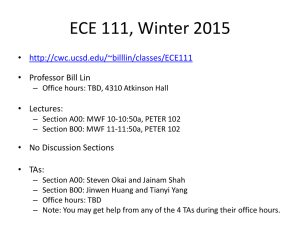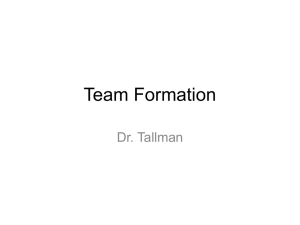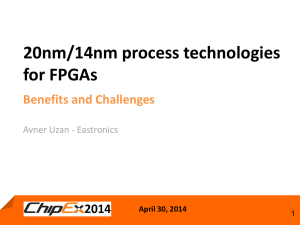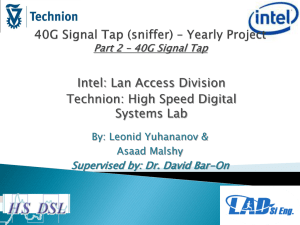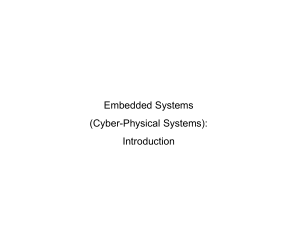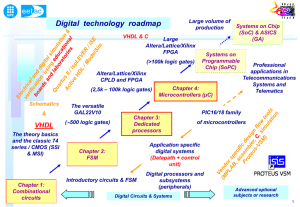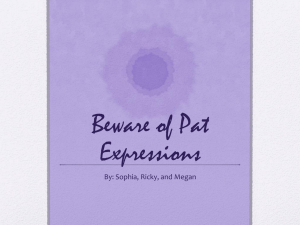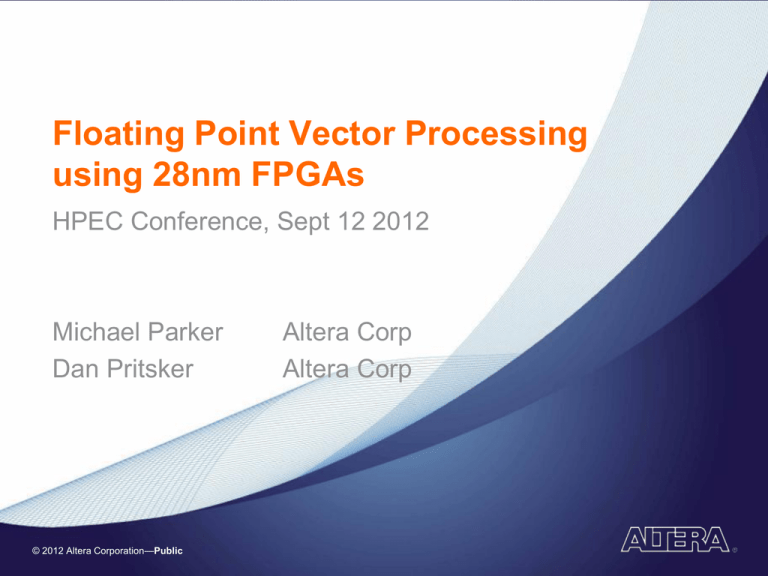
Floating Point Vector Processing
using 28nm FPGAs
HPEC Conference, Sept 12 2012
Michael Parker
Dan Pritsker
© 2012 Altera Corporation—Public
Altera Corp
Altera Corp
28-nm DSP Architecture on Stratix V FPGAs
User-programmable variable-precision
signal processing
Optimized for single- and double-precision
floating point
Supports 1-TFLOP processing capability
© 2010 Altera Corporation—Public
ALTERA, ARRIA, CYCLONE, HARDCOPY, MAX, MEGACORE, NIOS, QUARTUS & STRATIX are Reg. U.S. Pat. & Tm. Off.
and Altera marks in and outside the U.S.
2
Why Floating Point at 28nm ?
Floating point density determined by hard multiplier density
Multipliers must efficiently support floating point mantissa
sizes
Multipliers vs Stratix III / IV / V
4500
4000
3500
3000
3.2x
2500
18x18 Mults
SP FP Mults
2000
DP FP Mults
1500
1.4x
1000
6.4x
500
4x
1.4x
0
EP3SE110
EP4SGX230
5SGS720
5SGSB8
65nm
40nm
28nm
© 2010 Altera Corporation—Public
ALTERA, ARRIA, CYCLONE, HARDCOPY, MAX, MEGACORE, NIOS, QUARTUS & STRATIX are Reg. U.S. Pat. & Tm. Off.
and Altera marks in and outside the U.S.
3
Floating Point Multiplier Capabilities
Floating point density determined by hard multiplier density
Multipliers must efficiently support floating point mantissa
sizes
Multipliers vs Stratix III / IV / V
4500
3926
4000
3500
3000
3.2x
2500
18x18 Mults
1963
2000
DP FP Mults
1288
1500
1000
500
1.4x
896
224 89
0
6.4x
322
490
128
4x
1.4x
EP3SE110
EP4SGX230
5SGS720
5SGSD8
65nm
40nm
28nm
© 2010 Altera Corporation—Public
ALTERA, ARRIA, CYCLONE, HARDCOPY, MAX, MEGACORE, NIOS, QUARTUS & STRATIX are Reg. U.S. Pat. & Tm. Off.
and Altera marks in and outside the U.S.
4
SP FP Mults
Floating-point Methodology
Processors – each floating-point
operation supports IEEE 754 format
Inefficient format for FPGAs
Not 2’s complement
Special cases, error conditions
Exponential normalization for each step
Excessive routing requirement resulting in low
performance and high logic usage
Result: FPGAs restricted to fixed point
Denormalize
Normalize
© 2010 Altera Corporation—Public
ALTERA, ARRIA, CYCLONE, HARDCOPY, MAX, MEGACORE, NIOS, QUARTUS & STRATIX are Reg. U.S. Pat. & Tm. Off.
and Altera marks in and outside the U.S.
5
New Floating-point Methodology
Processors – each floating-point
operation supports IEEE 754 format
Inefficient format for FPGAs
Not 2’s complement
Special cases, error conditions
Exponential normalization for each step
Excessive routing requirement resulting in low
performance and high logic usage
Result: FPGAs restricted to fixed point
Novel approach: fused datapath
IEEE 754 interface only at algorithm boundaries
Signed, fractional mantissa
Increases mantissa precision → reduces need for
normalization
Result: 200-250 MHz performance with large
complex floating-point designs
Slightly Larger –
Wider Operands
Denormalize
True Floating Mantissa
(Not Just 1.0 – 1.99..)
Normalize
Remove
Normalization
Do Not Apply
Special and Error
Conditions Here
© 2010 Altera Corporation—Public
ALTERA, ARRIA, CYCLONE, HARDCOPY, MAX, MEGACORE, NIOS, QUARTUS & STRATIX are Reg. U.S. Pat. & Tm. Off.
and Altera marks in and outside the U.S.
6
Vector Dot Product Example
X
+
X
+
X
+
X
+
X
+
X
Normalize
+
X
+
X
DeNormalize
© 2010 Altera Corporation—Public
ALTERA, ARRIA, CYCLONE, HARDCOPY, MAX, MEGACORE, NIOS, QUARTUS & STRATIX are Reg. U.S. Pat. & Tm. Off.
and Altera marks in and outside the U.S.
7
Selection of IEEE Precisions
IEEE format
7 precisions (including double and single)
float16_m10
float26_m17
float32_m23 (IEEE single)
float35_m26
float46_m35
float55_m44
float64_m52 (IEEE double)
Precision
DSP usage compared to
single precision
f16m10
f26m17
f32m23
f35m26
f46m35
f55m44
f64m52
0.6
0.9
1
1.2
2.2
3.7
5.0
Logic usage
compared to single
precision
0.3
0.6
1
1.4
2.2
3.4
4.6
© 2010 Altera Corporation—Public
ALTERA, ARRIA, CYCLONE, HARDCOPY, MAX, MEGACORE, NIOS, QUARTUS & STRATIX are Reg. U.S. Pat. & Tm. Off.
and Altera marks in and outside the U.S.
8
Elementary Mathematical Functions
Selectable Precision Floating Point
Round
floor(x)
ceil(x)
round(x)
rint(x)
Trigonometric
sin(a)
cos(a)
sincos(a)
tan(a)
cot(a)
sin(pi*x)
cos(pi*x)
tan(pi*x)
cot(pi*x)
asin(a)
acos(a)
atan(a)
atan2(y,x)
asin(x)/pi
acos(x)/pi
atan(x)/pi
Math
exp(x)
log(x)
recip(x)
hypot(x,y)
mod(x,y)
Sqrt
sqrt(x)
recipSqrt(x)
cbrt(x)
Min Max
min(a,b)
max(a,b)
dim(a,b)
sat(a,hi,lo)
ldexp(x,b)
ilogb(x)
The new fn(pi*x) and fn(x)/pi trig functions are particularly
logic efficient when used in floating point designs
Highlighted functions are limited to IEEE single and double
© 2010 Altera Corporation—Public
ALTERA, ARRIA, CYCLONE, HARDCOPY, MAX, MEGACORE, NIOS, QUARTUS & STRATIX are Reg. U.S. Pat. & Tm. Off.
and Altera marks in and outside the U.S.
9
LdExp
QR Decomposition Algorithm
Implementation
© 2012 Altera Corporation—Public
QR Decomposition
QR Solver finds solution for Ax=b linear equation system
using QR decomposition, where Q is ortho-normal and R
is upper-triangular matrix. A can be rectangular.
Steps of Solver
Decomposition:
A=Q·R
Ortho-normal property:
QT · Q = I
Substitute then mult by QT:
Q·R·x=b
R · x = QT · b = y
Backward Substitution:
QT · b = y
solve R · x = y
Decomposition is done using Gram-Schmidt derived
algorithms. Most of computational effort is in “dot-product”
© 2010 Altera Corporation—Public
ALTERA, ARRIA, CYCLONE, HARDCOPY, MAX, MEGACORE, NIOS, QUARTUS & STRATIX are Reg. U.S. Pat. & Tm. Off.
and Altera marks in and outside the U.S.
11
Block Diagram
Stimulus
[m x n]
A
QR Decomposition
R
Backward
Substitution
+
[m]
b
Q MatrixT * Input
Vector
y
Solve for x in Ax = b where A is nonsymmetric, may be rectangular
© 2010 Altera Corporation—Public
ALTERA, ARRIA, CYCLONE, HARDCOPY, MAX, MEGACORE, NIOS, QUARTUS & STRATIX are Reg. U.S. Pat. & Tm. Off.
and Altera marks in and outside the U.S.
12
x
QR Decomposition Algorithm
for k=1:n
r(k,k) = norm(A(1:m, k));
for j = k+1:n
r(k, j) = dot(A(1:m, k), A(1:m, j)) / r(k,k);
end
q(1:m, k) = A(1:m, k) / r(k,k);
for j = k+1:n
A(1:m, j) = A(1:m, j) - r(k, j) * q(1:m, k);
end
end
Standard algorithm, source: Numerical Recipes in C
Possible to implement as is, but changes make it FPGA friendly and increase
numerical accuracy and stability
© 2010 Altera Corporation—Public
ALTERA, ARRIA, CYCLONE, HARDCOPY, MAX, MEGACORE, NIOS, QUARTUS & STRATIX are Reg. U.S. Pat. & Tm. Off.
and Altera marks in and outside the U.S.
13
Algorithm - Observations
for k=1:n
r(k,k) = sqrt(dot(A(1:m, k), A(1:m,k));
k sqrt,
for j = k+1:n
r(k, j) = dot(A(1:m, k), A(1:m, j)) / r(k,k);
end
q(1:m, k) = A(1:m, k) / r(k,k);
k divides
for j = k+1:n
A(1:m, j) = A(1:m, j) - r(k, j) * q(1:m, k);
end
end
k*m cmults
k2/2 divides, m*k2/2 cmults
m*k2/2 cmults
Replaced norm function with sqrt and dot functions, as they are available as hardware
components.
k sqrt
k2/2 + k divides
m*k2 complex mults
© 2010 Altera Corporation—Public
ALTERA, ARRIA, CYCLONE, HARDCOPY, MAX, MEGACORE, NIOS, QUARTUS & STRATIX are Reg. U.S. Pat. & Tm. Off.
and Altera marks in and outside the U.S.
14
Algorithm - Data Dependencies
for k=1:n
r(k,k) = sqrt(dot(A(1:m, k), A(1:m,k));
for j = k+1:n
r(k, j) = dot(A(1:m, k), A(1:m, j)) / r(k,k); r(k,k) required at
end
q(1:m, k) = A(1:m, k) / r(k,k); r(k,k) required at this stage
for j = k+1:n
A(1:m, j) = A(1:m, j) - r(k, j) * q(1:m, k); q(1:m,k) required
end
this stage
end
Floating point functions may have long latencies
Dependencies introduce stalls in data flow
Neither r(k,j) nor q can be calculated before r(k,k) is available
A(1:m,j) cannot be calculated before q is available
© 2010 Altera Corporation—Public
ALTERA, ARRIA, CYCLONE, HARDCOPY, MAX, MEGACORE, NIOS, QUARTUS & STRATIX are Reg. U.S. Pat. & Tm. Off.
and Altera marks in and outside the U.S.
15
this stage
at
Algorithm - Splitting Operations
for k=1:n
%% r(k,k) = sqrt(dot(A(1:m, k), A(1:m,k));
r2(k,k) = dot(A(1:m, k), A(1:m,k);
r(k,k) = sqrt(r2(k,k));
for j = k+1:n
%% r(k, j) = dot(A(1:m, k), A(1:m, j)) / r(k,k);
rn(k, j) = dot(A(1:m, k), A(1:m, j));
r(k, j) = rn(k,j)/ r(k,k);
end
q(1:m, k) = A(1:m, k) / r(k,k);
for j = k+1:n
A(1:m, j) = A(1:m, j) - r(k,j) * q(1:m,k);
end
end
© 2010 Altera Corporation—Public
ALTERA, ARRIA, CYCLONE, HARDCOPY, MAX, MEGACORE, NIOS, QUARTUS & STRATIX are Reg. U.S. Pat. & Tm. Off.
and Altera marks in and outside the U.S.
16
Algorithm - Substitutions
for k=1:n
r2(k,k) = dot(A(1:m, k), A(1:m,k);
r(k,k) = sqrt(r2(k,k));
for j = k+1:n
rn(k, j) = dot(A(1:m, k), A(1:m, j));
r(k, j) = rn(k,j)/ r(k,k);
end
Replace q(1:m,k)
q(1:m, k) = A(1:m, k) / r(k,k);
for j = k+1:n
A(1:m, j) = A(1:m, j) - r(k,j) * q(1:m,k);
end
end
with A(1:m,k) / r(k,k)
Replace r(k,j) with rn(k,j)/ r(k,k)
© 2010 Altera Corporation—Public
ALTERA, ARRIA, CYCLONE, HARDCOPY, MAX, MEGACORE, NIOS, QUARTUS & STRATIX are Reg. U.S. Pat. & Tm. Off.
and Altera marks in and outside the U.S.
17
Algorithm - After Substitutions
for k=1:n
r2(k,k) = dot(A(1:m, k), A(1:m,k);
r(k,k) = sqrt(r2(k,k));
for j = k+1:n
rn(k, j) = dot(A(1:m, k), A(1:m, j));
r(k, j) = rn(k,j)/ r(k,k);
end
q(1:m, k) = A(1:m, k) / r(k,k);
for j = k+1:n
A(1:m, j) = A(1:m, j) - rn(k,j)/ r(k,k) * A(1:m,k) / r(k,k) ;
end
end
© 2010 Altera Corporation—Public
ALTERA, ARRIA, CYCLONE, HARDCOPY, MAX, MEGACORE, NIOS, QUARTUS & STRATIX are Reg. U.S. Pat. & Tm. Off.
and Altera marks in and outside the U.S.
18
Algorithm - Re-Ordering
for k=1:n
r2(k,k) = dot(A(1:m, k), A(1:m,k);
for j = k+1:n
rn(k, j) = dot(A(1:m, k), A(1:m, j));
end
for j = k+1:n
A(1:m, j) = A(1:m, j) – (rn(k,j) / r2(k,k)) * A(1:m,k);
end
end
for k=1:n
r(k,k) = sqrt(r2(k,k));
for j = k+1:n
r(k, j) = rn(k,j)/ r(k,k);
end
q(1:m, k) = A(1:m, k) / r(k,k);
end
© 2010 Altera Corporation—Public
ALTERA, ARRIA, CYCLONE, HARDCOPY, MAX, MEGACORE, NIOS, QUARTUS & STRATIX are Reg. U.S. Pat. & Tm. Off.
and Altera marks in and outside the U.S.
19
Algorithm - Flow Advantages
for k=1:n
r2(k,k) = dot(A(1:m, k), A(1:m,k);
No sqrt
for j = k+1:n
Less operations in
rn(k, j) = dot(A(1:m, k), A(1:m, j));
end
calculation of “A”
for j = k+1:n
A(1:m, j) = A(1:m, j) - rn(k,j) * A(1:m,k) / r2(k,k) ;
end
end
for k=1:n
r(k,k) = sqrt(r2(k,k));
for j = k+1:n
r(k, j) = rn(k,j)/ r(k,k);
end
q(1:m, k) = A(1:m, k) / r(k,k);
end
Split out:
Operations can
be scheduled as data
becomes available
© 2010 Altera Corporation—Public
ALTERA, ARRIA, CYCLONE, HARDCOPY, MAX, MEGACORE, NIOS, QUARTUS & STRATIX are Reg. U.S. Pat. & Tm. Off.
and Altera marks in and outside the U.S.
20
critical path
Algorithm - Number of Calculations
for k=1:n
k*m complex mults
r2(k,k) = dot(A(1:m, k), A(1:m,k);
for j = k+1:n
m*k2/2 complex mults
rn(k, j) = dot(A(1:m, k), A(1:m, j));
end
k2/2 divides, m*k2/2 complex
for j = k+1:n
A(1:m, j) = A(1:m, j) – (rn(k,j)/r2(k,k)) * A(1:m,k);
end
end
for k=1:n
r(k,k) = sqrt(r2(k,k));
for j = k+1:n
r(k, j) = rn(k,j)/ r(k,k);
end
q(1:m, k) = A(1:m, k) / r(k,k);
end
mults
k sqrts
k2/2 divides
k divides
k sqrt
k2 + k divides - twice as many as original, but still only 1 divider per m complex mults
m*(k2+k) complex mults
© 2010 Altera Corporation—Public
ALTERA, ARRIA, CYCLONE, HARDCOPY, MAX, MEGACORE, NIOS, QUARTUS & STRATIX are Reg. U.S. Pat. & Tm. Off.
and Altera marks in and outside the U.S.
21
QRD Structure
v
A
n
div/sqrt unit
m/v
m
mult/add unit
Ak
control
Addresses,
instructions
rk,j
r2k,k
Fifo (“leaky bucket”)
instr
In 1
In 2
mag
A
---
dot
A
Ak
div
sub
© 2010 Altera Corporation—Public
ALTERA, ARRIA, CYCLONE, HARDCOPY, MAX, MEGACORE, NIOS, QUARTUS & STRATIX are Reg. U.S. Pat. & Tm. Off.
and Altera marks in and outside the U.S.
22
A
In 3
Ak
rk
Ak
rk,j/r2k,k
Stratix V Floating Point QRD
Benchmarks
© 2012 Altera Corporation—Public
Altera 28nm high end FPGAs
Stratix V “GS” Family
Part
Number
LEs /
ALUTs
ALUTs /
Registers
DSP Multiplier
Count
Mbits / M20
memory
blocks
14 GBps
Transceiver
Count
5SGSD3
236K
178K / 356K
1200
13 / 688
24
5SGSD4
360K
272K / 543K
2088
19 / 957
36
5SGSD5
457K
345K / 690K
3180
39 / 2014
36
5SGSD6
583K
440K / 880K
3550
45 / 2320
48
5SGSD8
695K
525K / 1050K
3926
50 / 2567
48
© 2010 Altera Corporation—Public
ALTERA, ARRIA, CYCLONE, HARDCOPY, MAX, MEGACORE, NIOS, QUARTUS & STRATIX are Reg. U.S. Pat. & Tm. Off.
and Altera marks in and outside the U.S.
24
Performance and FPGA Resources
QR Decomposition Parameterizable Core using 5SGSD5
Complex
Input Matrix
Size
50x100
100x200
100x200
250x400
400x400
Vector
Size
50
50
100
100
100
© 2010 Altera Corporation—Public
ALUTs /
% ALUTs /
% Memory
blocks /
Latency @
Operating
frequency
27x27s
105K
% 27x27s
30%
GFLOPS per
core (complex
single
precision)
Memory
blocks /
45 us @
43.8
230 M20K
11%
250 MHz
227 DSP
106K
14%
31%
213 us @
304 M20K
15%
250 MHz
228 DSP
202K
14%
58%
173 us @
504 M20K
25%
200 MHz
428 DSP
200K
27%
58%
1586 us @
858 M20K
43%
200 MHz
428 DSP
203K
27%
59%
4029 us @
1566 M20K
78%
200 MHz
428 DSP
27%
ALTERA, ARRIA, CYCLONE, HARDCOPY, MAX, MEGACORE, NIOS, QUARTUS & STRATIX are Reg. U.S. Pat. & Tm. Off.
and Altera marks in and outside the U.S.
25
64.3
91.9
106
106
GFLOPs and GFLOPs/Watt
QR Decomposition Parameterizable Core using 5SGSD5
Complex
Input Matrix
Size
Vector
Size
Through-put
GFLOPS per
(Matrix per
core (complex
second)
single precision)
50x100
50
31,681
43.8
Core power
consumption as
measured using
Altera 5SGSD5
eval board
10.8 W
100x200
50
5,920
64.3
13.9 W
4.6
100x200
100
8,467
91.9
21.0 W
4.4
400x400
100
310
106
25.2 W
4.2
450x450
75
165
80.0
20.2
4.0
(n x m)
Complex QRD FLOPs = 5.33mn2 + 8mn – 2n + 4n2
© 2010 Altera Corporation—Public
ALTERA, ARRIA, CYCLONE, HARDCOPY, MAX, MEGACORE, NIOS, QUARTUS & STRATIX are Reg. U.S. Pat. & Tm. Off.
and Altera marks in and outside the U.S.
26
GFLOPs/Watt
4.1
Verification and Accuracy
© 2012 Altera Corporation—Public
Running the Design
Initialization feedback in Matlab window
© 2010 Altera Corporation—Public
ALTERA, ARRIA, CYCLONE, HARDCOPY, MAX, MEGACORE, NIOS, QUARTUS & STRATIX are Reg. U.S. Pat. & Tm. Off.
and Altera marks in and outside the U.S.
Running the Design
After simulation run analyze_DSPBA_out.m
© 2010 Altera Corporation—Public
ALTERA, ARRIA, CYCLONE, HARDCOPY, MAX, MEGACORE, NIOS, QUARTUS & STRATIX are Reg. U.S. Pat. & Tm. Off.
and Altera marks in and outside the U.S.
Computational error analysis
QR Decomposition Accuracy
Complex Input
Matrix Size
Vector Size
MATLAB using
computer Norm/Max
DSPBA generated RTL
Norm/Max
50x100
50
5.01e-5 / 6.42e-6
4.87e-5 / 6.02e-6
100x200
100
2.3e-5 / 1.24e-6
1.68e-5 / 9.97e-7
400x400
100
8.8e-5 / 4.81e-6
7.07e-5 / 4.03e-6
(n x m)
using Frobenius norm
E
Using Single Precision Floating Point
© 2010 Altera Corporation—Public
ALTERA, ARRIA, CYCLONE, HARDCOPY, MAX, MEGACORE, NIOS, QUARTUS & STRATIX are Reg. U.S. Pat. & Tm. Off.
and Altera marks in and outside the U.S.
31
F
n
m
i 1
j 1
e ij
2
Shipping today as reference designs
© 2010 Altera Corporation—Public
ALTERA, ARRIA, CYCLONE, HARDCOPY, MAX, MEGACORE, NIOS, QUARTUS & STRATIX are Reg. U.S. Pat. & Tm. Off.
and Altera marks in and outside the U.S.
32
Third party benchmarking by BDTI
© 2010 Altera Corporation—Public
ALTERA, ARRIA, CYCLONE, HARDCOPY, MAX, MEGACORE, NIOS, QUARTUS & STRATIX are Reg. U.S. Pat. & Tm. Off.
and Altera marks in and outside the U.S.
33
Thank you
© 2012 Altera Corporation—Public

